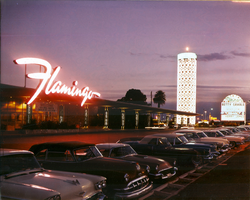Search the Special Collections and Archives Portal
Search Results

Transcript of interview with Adelaide Robbins by Lisa Gioia-Acres, April 18, 2008
Date
Archival Collection
Description
Adelaide was born in Manhattan, New York to a father who was a pianist and arranger and a mother who was a dancer on Broadway. She grew up as an only child in the theater district where she was exposed to the arts from a young age. Her parents insisted she be well rounded. To that end, she began piano lessons at age six and was frequently taken to museums. Adelaide was always drawn to music and began working professionally by the age of 12. She attended the High School of Music and Art for four years along with others who went on to great fame. While in high school, she earned awards for composition. Her knowledge and abilities of the bass earned her a full scholarship to the Eastman School of Music. All of the jobs she had during high school and college were music related; playing gigs or teaching. While working towards a triple major at Eastman, she felt over-extended and eventually transferred to the Manhattan School of Music who was honored to have a transfer from Eastman. Also because of the extra credits from Eastman, she was able to obtain a master’s degree inside of a year. Adelaide went on the road with Buddy Rich’s band where they played in Chicago and Los Angeles before finding their way to Las Vegas. Adelaide was always the only woman in the band, and there were difficulties of being a woman in the field of mostly male musicians. The band found their way to Las Vegas in 1967. She never realized how well known she was until she arrived in Las Vegas. Adelaide came to Las Vegas on a trial run and ended up staying. The first job she had in Las Vegas was playing solo piano at Guys and Dolls before moving on to playing as a rehearsal pianist for a Broadway show. Over the years, Adelaide played many venues with many famous musicians. She is not hopeful for the future of musicians in Las Vegas, feeling the casino owners would rather replace live musicians with canned music. However, Adelaide’s career is not over as she is still performing for a variety of events. With her two degrees from very prominent music schools, Adelaide feels she may have gone further in career if she had stayed in New York, but she has no regrets about coming to Las Vegas.
Text

Photograph of the Flamingo Hotel at sunset, Las Vegas, circa mid 1950s
Date
Archival Collection
Description
Image

Photograph of individuals at Special Collections, University of Nevada, Las Vegas, September 1975
Date
Archival Collection
Description
From left to right: Susan Jarvis, Hal Erickson, and Alfreda Blood in the Special Collections department at the University of Nevada, Las Vegas (UNLV). They are examining the Leonard T. Blood papers just donated to UNLV Special Collections.
Image
Paul J. Richert Photograph Collection
Identifier
Abstract
The Paul J. Richert Photograph Collection (approximately 1950-1951) consists of black-and-white photographic prints and negatives depicting the swimming pools at the Desert Inn and Flamingo Hotel & Casino in Las Vegas, Nevada. Also included is an image of the Las Vegas High School Rhythmettes dance group and an image of the El Rancho Hotel and Casino in Las Vegas.
Archival Collection
Nadine Tobin Collection of Helldorado Photographs
Identifier
Abstract
The Nadine Tobin Collection of Helldorado Photographs, approximately 1940 to 1959, contains black-and-white photographic prints depicting parade floats during Helldorado Days celebrations in Las Vegas, Nevada. Also included is one image of a primary school class in Las Vegas.
Archival Collection
First Good Shepherd Lutheran Church Photograph Collection
Identifier
Abstract
The First Good Shepherd Lutheran Church Photograph Collection, approximately 1930 to 1950, consists of black-and-white photographic prints and negatives depicting the construction of the Good Shepherd Lutheran Church in Las Vegas, Nevada. Also included are images of parish leaders and the ground breaking ceremony for the grand opening.
Archival Collection
Castaways Hotel and Casino Photograph Collection
Identifier
Abstract
The Castaways Hotel and Casino Photograph Collection, approximately 1963 to 1987, consists of black-and-white and color photographic prints and negatives. Images depict the exterior of the entrance to the property, the mega-pylon sign, the pool area, and the “Gateway to Luck” replica temple in the courtyard area. The interior images depict various hotel rooms and suites, a couple dining, and a performance by Rusty Isabel, an entertainer in the Kon Tiki Lounge inside the property.
Archival Collection
Lawrence Revere Papers
Identifier
Abstract
The Lawrence Revere Papers primarily consist of correspondence between Lawrence Revere and the developers of blackjack betting systems dating from 1965 to 1970. The collection includes information about blackjack gambling systems, correspondence with gambling experts, and press material regarding the publication of Revere's book
Archival Collection
Index card envelopes cataloging films released between 1937 and 1977; includes titles, release details, credits, and newspaper and magazine clippings highlighting each film's premiere, approximately 1950 to 1977
Level of Description
Archival Collection
Collection Name: Howard Hughes Film Production Records
Box/Folder: Box 431 (Restrictions apply), Box 432 (Restrictions apply), Box 433 (Restrictions apply), Box 434 (Restrictions apply), Box 435 (Restrictions apply), Box 436 (Restrictions apply), Box 437 (Restrictions apply), Box 438 (Restrictions apply), Box 439 (Restrictions apply), Box 440 (Restrictions apply), Box 441 (Restrictions apply), Box 442 (Restrictions apply), Box 443 (Restrictions apply), Box 444 (Restrictions apply), Box 445 (Restrictions apply), Box 446 (Restrictions apply), Box 447 (Restrictions apply), Box 448 (Restrictions apply), Box 449 (Restrictions apply), Box 450 (Restrictions apply), Box 451 (Restrictions apply), Box 452 (Restrictions apply), Box 453 (Restrictions apply), Box 454 (Restrictions apply), Box 455 (Restrictions apply), Box 456 (Restrictions apply), Box 457 (Restrictions apply), Box 458 (Restrictions apply), Box 459 (Restrictions apply), Box 460 (Restrictions apply), Box 461 (Restrictions apply), Box 462 (Restrictions apply), Box 463 (Restrictions apply), Box 464 (Restrictions apply), Box 465 (Restrictions apply), Box 466 (Restrictions apply), Box 467 (Restrictions apply), Box 468 (Restrictions apply), Box 469 (Restrictions apply), Box 470 (Restrictions apply), Box 471 (Restrictions apply), Box 472 (Restrictions apply), Box 473 (Restrictions apply), Box 474 (Restrictions apply), Box 475 (Restrictions apply), Box 476 (Restrictions apply)
Archival Component

Transcript of interview with Dorothy Eisenberg by Caryll Batt Dziedziak, November 14, 2006
Date
Archival Collection
Description
Text
